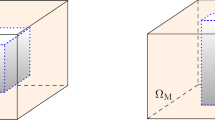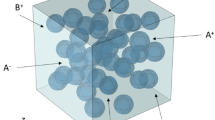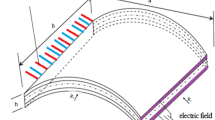Abstract
A model for numerical homogenization of triply periodic minimal surfaces (TPMS) based on electrostrictive composites is presented. This electrostrictive composite consists of TPMS (a three-dimensional continuous structure) implanted in a soft non-electrostrictive matrix. A representative volume element (RVE)-based approach is used to homogenize the electrostrictive composites and determine all the effective electrostrictive, mechanical, and electrical coefficients. Finite element formulation is employed to solve the nonlinear electrostrictive constitutive equations. Special attention is paid to designing the boundary conditions that permit the fast calculation based on simulations of overall deformation-induced due to mechanical and electrical loads. Interestingly, the value of the effective electrostrictive coefficient of the composite surpasses that of the inclusion Pb (mg1/3Nb2/3)O3-PbTO3-BaTiO3 (PMN-PT-BT), even though the matrix is non-electrostrictive due to the additional flexibility imparted by the matrix. This electrostrictive response of TPMS-based composite is independent of the type of TPMS structures used. It is prudent to say that these composites will find their place in practical application owing to their salient features of more flexibility and high electrostrictive coefficient.








Similar content being viewed by others
References
Zhuang, X., Nguyen, C., Nanthakumar, S.S., Chamoin, L., Jin, Y., Rabczuk, T.: Inverse design of reconfigurable piezoelectric topological phononic plates. Mater. Des. 219 110760 (2022)
Mortazavi, B., Shojaei, F., Javvaji, B., Rabczuk, T., Zhuang, X.: Outstandingly high thermal conductivity, elastic modulus, carrier mobility and piezoelectricity in two-dimensional semiconducting CrC2N4: a first-principles study. Mater. Today Energy. 22, 100839 (2021)
Ghasemi, H., Park, H.S., Rabczuk, T.: A multi-material level set-based topology optimization of flexoelectric composites. Comput. Methods Appl. Mech. Eng. 332, 47–62 (2018)
Ghasemi, H., Park, H.S., Zhuang, X., Rabczuk, T.: Three-dimensional isogeometric analysis of flexoelectricity with MATLAB implementation. Comput. Mater. Contin. 65, 1157–1179 (2020)
Hamdia, K.M., Ghasemi, H., Zhuang, X., Rabczuk, T.: Multilevel Monte Carlo method for topology optimization of flexoelectric composites with uncertain material properties. Eng. Anal. Bound. Elem. 134, 412–418 (2022)
Sharma, S., Kumar, R., Talha, M., Vaish, R.: Flexoelectric poling of functionally graded ferroelectric materials. Adv. Theory Simul. 4, 2000158 (2021)
Diguet, G., Cavaille, J.-Y., Sebald, G., Takagi, T., Yabu, H., Suzuki, A., Miura, R.: Physical behavior of electrostrictive polymers. Part 1: Polarization forces. Comput. Mater. Sci. 190, 110294 (2021)
Tohluebaji, N., Thainiramit, P., Putson, C., Muensit, N.: Phase and structure behavior vs. electromechanical performance of electrostrictive P (VDF-HFP)/ZnO composite nanofibers. Polymers (Basel) 13, 2565 (2021)
Farhan, R., Eddiai, A., Meddad, M., Chakhchaoui, N., Rguiti, M., Mazroui, M.: Improvement in energy conversion of electrostrictive composite materials by new approach via piezoelectric effect: modeling and experiments. Polym. Adv. Technol. 32, 123–130 (2021)
Sundar, V., Newnham, R.E.: Electrostriction and polarization. Ferroelectrics 135, 431–446 (1992)
Hom, C.L., Shankar, N.: A fully coupled constitutive model for electrostrictive ceramic materials. J. Intell. Mater. Syst. Struct. 5, 795–801 (1994)
Hom, C.L., Shankar, N.: A finite element method for electrostrictive ceramic devices. Int. J. Solids Struct. 33, 1757–1779 (1996). https://doi.org/10.1016/0020-7683(95)00123-9
Bai, Y., Cheng, Z.-Y., Bharti, V., Xu, H.S., Zhang, Q.M.: High-dielectric-constant ceramic-powder polymer composites. Appl. Phys. Lett. 76, 3804–3806 (2000)
Wang, J.J., Meng, F.Y., Ma, X.Q., Xu, M.X., Chen, L.Q.: Lattice, elastic, polarization, and electrostrictive properties of BaTiO 3 from first-principles. J. Appl. Phys. 108, 34107 (2010)
Tang, T., Yu, W.: Effective nonlinear behavior of electrostrictive multiphase composites: a micromechanical study. Int. J. Eng. Sci. 48, 1769–1777 (2010)
Farhan, R., Eddiai, A., Meddad, M., Mazroui, M., Guyomar, D.: Electromechanical losses evaluation by energy-efficient method using the electrostrictive composites: experiments and modeling. Smart Mater. Struct. 28, 35024 (2019)
Li, J.Y.: The effective electroelastic moduli of textured piezoelectric polycrystalline aggregates. J. Mech. Phys. Solids 48, 529–552 (2000)
Fang, D.-N., Jiang, B., Hwang, K.-C.: A model for predicting effective properties of piezocomposites with non-piezoelectric inclusions. J. Elast. Phys. Sci. Solids. 62, 95–118 (2001)
Sabina, F.J., Rodrı́guez-Ramos, R., Bravo-Castillero, J., Guinovart-Dı́az, R.: Closed-form expressions for the effective coefficients of a fibre-reinforced composite with transversely isotropic constituents. II: Piezoelectric and hexagonal symmetry. J. Mech. Phys. Solids. 49, 1463–1479 (2001)
Aboudi, J.: Micromechanical prediction of the effective coefficients of thermo-piezoelectric multiphase composites. J. Intell. Mater. Syst. Struct. 9, 713–722 (1998)
Castaneda, P.P., Suquet, P.: Nonlinear composites. Adv. Appl. Mech. 34, 171–302 (1997)
Castañeda, P.P.: Exact second-order estimates for the effective mechanical properties of nonlinear composite materials. J. Mech. Phys. Solids. 44, 827–862 (1996)
Willis, J.R.: On methods for bounding the overall properties of nonlinear composites. J. Mech. Phys. Solids 39, 73–86 (1991)
Talbot, D.R.S., Willis, J.R.: Three-point bounds for the overall properties of a nonlinear composite dielectric. IMA J. Appl. Math. 57, 41–52 (1996)
Guillot, F.M., Jarzynski, J., Balizer, E.: Measurement of electrostrictive coefficients of polymer films. J. Acoust. Soc. Am. 110, 2980–2990 (2001)
Li, J., Rao, N.: Micromechanics of ferroelectric polymer-based electrostrictive composites. J. Mech. Phys. Solids 52, 591–615 (2004)
Lebrun, L., Guyomar, D., Guiffard, B., Cottinet, P.-J., Putson, C.: The Characterisation of the harvesting capabilities of an electrostrictive polymer composite. Sens Actuators A Phys. 153, 251–257 (2009)
Li, S., Xiong, D., Liu, M., Bai, S., Zhao, X.: Thermophysical properties of SiC/Al composites with three dimensional interpenetrating network structure. Ceram. Int. 40, 7539–7544 (2014)
Cheng, F., Kim, S.-M., Reddy, J.N., Al-Rub, R.K.A.: Modeling of elastoplastic behavior of stainless-steel/bronze interpenetrating phase composites with damage evolution. Int. J. Plast. 61, 94–111 (2014)
Poniznik, Z., Salit, V., Basista, M., Gross, D.: Effective elastic properties of interpenetrating phase composites. Comput. Mater. Sci. 44, 813–820 (2008)
Al-Ketan, O., Abu Al-Rub, R.K.: Multifunctional mechanical metamaterials based on triply periodic minimal surface lattices. Adv. Eng. Mater. 21, 1900524 (2019)
Al-Ketan, O., Lee, D.-W., Rowshan, R., Al-Rub, R.K.A.: Functionally graded and multi-morphology sheet TPMS lattices: design, manufacturing, and mechanical properties. J. Mech. Behav. Biomed. Mater. 102, 103520 (2020)
Yang, N., Quan, Z., Zhang, D., Tian, Y.: Multi-morphology transition hybridization CAD design of minimal surface porous structures for use in tissue engineering. Comput. Des. 56, 11–21 (2014)
Yang, N., Du, C., Wang, S., Yang, Y., Zhang, C.: Mathematically defined gradient porous materials. Mater. Lett. 173, 136–140 (2016)
Yin, H., Liu, Z., Dai, J., Wen, G., Zhang, C.: Crushing behavior and optimization of sheet-based 3D periodic cellular structures. Compos. Part B Eng. 182, 107565 (2020)
Abueidda, D.W., Dalaq, A.S., Al-Rub, R.K.A., Younes, H.A.: Finite element predictions of effective multifunctional properties of interpenetrating phase composites with novel triply periodic solid shell architectured reinforcements. Int. J. Mech. Sci. 92, 80–89 (2015)
Dalaq, A.S., Abueidda, D.W., Al-Rub, R.K.A., Jasiuk, I.M.: Finite element prediction of effective elastic properties of interpenetrating phase composites with architectured 3D sheet reinforcements. Int. J. Solids Struct. 83, 169–182 (2016)
Dalaq, A.S., Abueidda, D.W., Al-Rub, R.K.A.: Mechanical properties of 3D printed interpenetrating phase composites with novel architectured 3D solid-sheet reinforcements. Compos. Part A Appl. Sci. Manuf. 84, 266–280 (2016)
Al-Rub, R.K.A., Abueidda, D.W., Dalaq, A.S.: Thermo-electro-mechanical properties of interpenetrating phase composites with periodic architectured reinforcements. In: From Creep Damage Mechanics to Homogenization Methods, pp. 1–18. Springer (2015)
Wang, L., Lau, J., Thomas, E.L., Boyce, M.C.: Co-continuous composite materials for stiffness, strength, and energy dissipation. Adv. Mater. 23, 1524–1529 (2011)
Abueidda, D.W., Dalaq, A.S., Al-Rub, R.K.A., Jasiuk, I.: Micromechanical finite element predictions of a reduced coefficient of thermal expansion for 3D periodic architectured interpenetrating phase composites. Compos. Struct. 133, 85–97 (2015)
Abueidda, D.W., Al-Rub, R.K.A., Dalaq, A.S., Younes, H.A., Al Ghaferi, A.A., Shah, T.K.: Electrical conductivity of 3D periodic architectured interpenetrating phase composites with carbon nanostructured-epoxy reinforcements. Compos. Sci. Technol. 118, 127–134 (2015)
Abueidda, D.W., Al-Rub, R.K.A., Dalaq, A.S., Lee, D.-W., Khan, K.A., Jasiuk, I.: Effective conductivities and elastic moduli of novel foams with triply periodic minimal surfaces. Mech. Mater. 95, 102–115 (2016)
Gandy, P.J.F., Bardhan, S., Mackay, A.L., Klinowski, J.: Nodal surface approximations to the P, G, D and I-WP triply periodic minimal surfaces. Chem. Phys. Lett. 336, 187–195 (2001)
Brakke, K.A.: The surface evolver. Exp. Math. 1, 141–165 (1992)
Novak, N., Al-Ketan, O., Krstulović-Opara, L., Rowshan, R., Al-Rub, R.K.A., Vesenjak, M., Ren, Z.: Quasi-static and dynamic compressive behaviour of sheet TPMS cellular structures. Compos. Struct. 266, 113801 (2021)
Xu, H., Xie, Y.M., Chan, R., Zhou, S.: Piezoelectric properties of triply periodic minimum surface structures. Compos. Sci. Technol. 200, 108417 (2020)
Debus, J.-C., Dubus, B., Coutte, J.: Finite element modeling of lead magnesium niobate electrostrictive materials: static analysis. J. Acoust. Soc. Am. 103, 3336–3343 (1998)
Devonshire, A.F.: Theory of ferroelectrics. Adv. Phys. 3, 85–130 (1954)
Suo, Z.: Mechanics concepts for failure in ferroelectric ceramics. Smart Struct. Mater. 112, 1–6 (1991)
Suquet, P.: Elements of homogenization theory for inelastic solid mechanics. In: Sanchez-Palencia, E., Zaoui, A. (eds.) Homogenization Techniques for Composite Media, pp. 194–278 (1987)
Powers, J.M., McLaughlin, E.A., Moffett, M.B.: PMN measurements at NUWC. NUWC Report, 918 (1995)
Hom, C.L., Pilgrim, S.M., Shankar, N., Bridger, K., Massuda, M., Winzer, S.R.: Calculation of quasi-static electromechanical coupling coefficients for electrostrictive ceramic materials. IEEE Trans. Ultrason. Ferroelectr. Freq. Control. 41, 542–551 (1994)
McLaughlin, E.A., Powers, J.M., Moffett, M.B., Janus, R.S.: Characterization of PMN‐PT‐La for use in high‐power electrostrictive projectors. 100, 2729 (1996)
Berger, H., Kari, S., Gabbert, U., Rodriguez-Ramos, R., Bravo-Castillero, J., Guinovart-Diaz, R., Sabina, F.J., Maugin, G.A.: Unit cell models of piezoelectric fiber composites for numerical and analytical calculation of effective properties. Smart Mater. Struct. 15, 451 (2006)
Van den Ende, D.A., Bory, B.F., Groen, W.A., Van Der Zwaag, S.: Properties of quasi 1–3 piezoelectric PZT-epoxy composites obtained by dielectrophoresis. Integr. Ferroelectr. 114, 108–118 (2010)
Eury, S., Yimnirun, R., Sundar, V., Moses, P.J., Jang, S.-J., Newnham, R.E.: Converse electrostriction in polymers and composites. Mater. Chem. Phys. 61, 18–23 (1999)
Author information
Authors and Affiliations
Corresponding author
Additional information
Publisher's Note
Springer Nature remains neutral with regard to jurisdictional claims in published maps and institutional affiliations.
Appendix A
Appendix A
Shape function \({N}_{i}\) for linear tetrahedral element is
where i varies from 1 to 4, and
where the superscript (i.e., 1, 2, 3, and 4) represents the node number and the subscript (i.e., 1, 2, and 3) represents the direction.
The elemental strain displacement matrix is
The elemental electric field and electric potential matrix is
Rights and permissions
Springer Nature or its licensor (e.g. a society or other partner) holds exclusive rights to this article under a publishing agreement with the author(s) or other rightsholder(s); author self-archiving of the accepted manuscript version of this article is solely governed by the terms of such publishing agreement and applicable law.
About this article
Cite this article
Singh, D., Sharma, S., Kumar, R. et al. Representative volume element model of triply periodic minimal surfaces (TPMS)-based electrostrictive composites for numerical evaluation of effective properties. Acta Mech 234, 355–375 (2023). https://doi.org/10.1007/s00707-022-03404-2
Received:
Revised:
Accepted:
Published:
Issue Date:
DOI: https://doi.org/10.1007/s00707-022-03404-2




